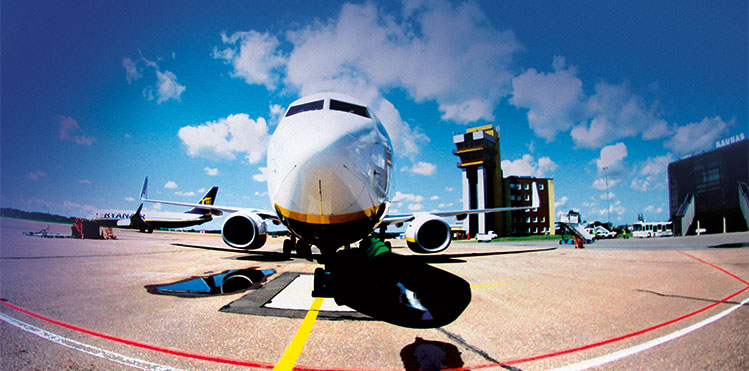
2015 was the first full-year of operation for Lithuanian Airports as a national airports’ network comprising Vilnius, Palanga and Kaunas airports. Gediminas Almantas, CEO Lithuanian Airports, outlined a synchronised strategy that prioritises improved connectivity, and efficient management and operations, to Ross Falconer.
The merger into one entity of Vilnius, Palanga and Kaunas airports has been a quantifiable success, while also establishing a clear strategic direction. The headline passenger figures show a record year for Lithuanian Airports in 2015, with 11.3% growth to 4.2 million across the three-airport network – a figure significantly exceeding the country’s population of 2.9 million.
Growth trends are evident at all three airports. Vilnius exceeded three million passengers for the first time last year, growing by 13.4% to 3.3 million, while Palanga grew by 9.4% and Kaunas by 3.2%. Indeed the propensity to fly and mobility of the catchment is a sustainable trend, with Lithuania’s airports recording a Compound Annual Growth Rate of 11.7% from 2005-2015, and double-digit growth is forecast to continue in 2016. “We expect to maintain the same growth rate. There might be some internal shift of the traffic inside the network, however, our market growth should deliver slightly better performance than in 2015,” explains Gediminas Almantas, CEO Lithuanian Airports.
While the collapse of home carrier Air Lituanica last May presented a challenge, the majority of routes were picked up by other airlines. Munich and Prague are two unserved routes that remain on the radar.
Almantas speaks passionately about developing all three airports, utilising underused capacity, and improving regional connectivity. “Lithuania is a geographical periphery in the context of the EU, with limited access to most EU capitals, except the neighbouring countries,” he says. “Neither rail nor road traffic constitute an alternative to air connectivity for both business and tourism. Air connectivity is vital for the integration of Lithuania. The country lost its flag carrier early enough to get an understanding of the disadvantages caused by loss of connectivity.”
Two new airlines will begin operations to Vilnius in June – Vueling to Barcelona and Germania to Zurich. Meanwhile, Wizz Air and Ryanair have both announced their expansion at the three Lithuanian airports, and LOT and Belavia will this year operate from both Vilnius and Palanga. Lithuanian Airports has introduced a new route and frequency increase support tool allowing it to promote air traffic development by supporting marketing and related route costs for a three-year period.
Meanwhile, Lithuanian Airports will in June launch a concession tender for a private investor to manage and develop Vilnius, Palanga and Kaunas airports for a 25-year period. Almantas comments that this “will be clearly focused on the improvement of connectivity, going beyond traditional CAPEX and concession fee priorities.”
Vilnius expansion in 2017

Gediminas Almantas, CEO Lithuanian Airports: “We clearly understand the importance of connectivity to the national economy, in particular for attracting foreign investments.”
There are already major investments planned at Vilnius in 2017, with the airport about to reach its terminal capacity of 3.5 million. Works will include both improvements to the terminal and renovation of the runway. Meanwhile, Kaunas Airport has already started a terminal reconstruction project, and Lithuanian Airports is investing in the non-aviation sector and the development of industrial areas at both Kaunas and Vilnius.
Kaunas has become a base for aviation-related businesses through the AEROHUB KUN investment project, which primarily focuses on MRO (maintenance, repair, and overhaul) service providers, OEM (original equipment manufacturer) and other spare part manufacturers and traders, as well as aircraft manufacturers and training service providers. The vision is for AEROHUB KUN to host a cluster of airspace-related services and activities. “The project has already received international attention and the first MRO case with investment from outside Europe is in the pipeline,” Almantas explains. “Two additional projects are expected for 2016, focusing on both MRO and cargo.”
Riding the digital wave
Behind all of these developments, the drive to increase connectivity and deliver new infrastructure, is a firm focus on the traveller. “We seriously started to think about the passenger experience two years ago and our progress is accelerating,” Almantas comments.
Central to the proposition is free unlimited WiFi at all three airports, and integrated solutions are on the way to enable passengers to track security waiting times and explore retail opportunities through their mobile devices – “shop in your taxi and get it at the gate”, as Almantas puts it. Lithuanian Airports plans to leverage the benefits of beacon technology to provide passengers with location-specific notifications via a new mobile app, which is currently being developed and will launch this year. The use of beacon technology enables the airport operator to proactively send notifications and offers to passengers.
A recent experiment with an airport cinema, “FilmBox”, also received great feedback both from passengers and Lithuanian media.
Lithuanian Airports is hosting this year’s ACI EUROPE Regional Airports’ Conference & Exhibition in Vilnius, 11-13 May, so delegates will have the opportunity to experience these myriad enhancements for themselves, as well as the city’s famous baroque architecture and UNESCO World Heritage-listed old town. “I am sure we are going to surprise newcomers visiting Vilnius for the first time, and even those who have been before,” Almantas concludes.







